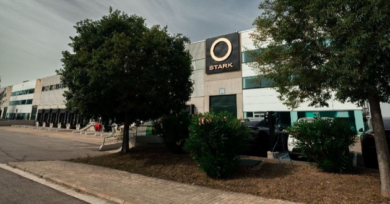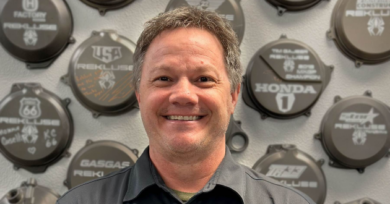July 23, 2007 – Is there a market for a larger-displacement ATV?
By Steve Bauer
Managing Editor
LAS VEGAS — The ballroom at the Rio Hotel in Las Vegas was a frenzied mix of cheers and applause as Arctic Cat’s 950cc ThunderCat 1000 roared on stage, filling the room with smoke as it spun its rear wheels in a show of force. The demonstration held in mid-June left the room of dealers and media buzzing, and the company’s new power-driven ATV has the industry wondering if there’s a market for larger, more powerful engines, and what concern, if any, is there over consumers handling these vehicles safely.
Market demand
Ole Tweet, vice president of new product development for Arctic Cat’s ATV Group, says the company believes the market demand is there for an engine that can deliver more power and quicker acceleration.
“Our world is about getting better, doing things better and being perceptive at providing the consumer with what they want,” Tweet said. “And its obvious from the sales of the 800cc class that the ATV customer is interested in more power, more ability to do stuff. We didn’t build the ThunderCat as a speed machine. It’s not a particularly high-velocity machine. It has power, which we feel can be used very effectively in heavier jobs, bigger loads and of course for a lot of things. And just to have the ability to have a little quicker acceleration is good. I don’t know if we have done anything but further the breed by bringing this out and we wanted to show the technical expertise and capabilities of our vehicles.”
Glenn Hansen, communications manager for American Suzuki Motor Corp., says it’s up to the consumers to decide whether there’s a market for such large machines.
“When we launched our KingQuad 700 a couple years ago, it was at the time our biggest engine in ATV, but it wasn’t the biggest engine in the industry, and some journalist questioned us why we didn’t go bigger,” he said. “And we responded by saying that we’d let the consumers decide if it was big enough. We certainly think it’s the right power mix and the right performance package overall, and that’s how we as a company design all our products. It certainly isn’t just about displacement. When you put a bigger engine in something, price and weight are going to go up, and we certainly don’t see a market there for a machine that’s more than $10,000.”
A number of Arctic Cat dealers, who will be selling the ThunderCat at its MSRP of $10,499, say although interest in the new machine has been high, they see it more as an image product rather than one that will be a big seller.
Terry Shruk, owner of Terry’s Truck and RV accessories in Mountain Home, Idaho, believes the ThunderCat’s introduction puts the rest of the industry on notice, and it fills a hole that Arctic Cat has had in its big bore ATV lineup for some time.
“We’ve had people who own our competitors’ machines stop in and ask if we have a ThunderCat in yet. So yes, I’ve had a handful of people who have already commented on it,” Shruk said. “I don’t know if they want to buy it, but they definitely want to see it. This won’t be a big selling point for us, but it fits the niche. The selling point is still the 400s and 650s. And at some point if they come out with a 400 EFI, it will be a big seller for us. As far as big bore ATVs go, we can now say that we’ve got the biggest and baddest one out there. This is a big step for Arctic Cat, because if they would have come out with a 700 or 800cc this year, I think they’d be labeled a copycat. I think this was an eye-opener for the other manufacturers telling them that Arctic Cat isn’t content to just stand around and follow.”
Mike Larson, owner of Larson Cycle in Cambridge, Minn., says although the market for the ThunderCat is yet to be determined, he doesn’t see it filling a significant consumer need.
“It will be received well by some people, but I think it’s more a measuring contest than anything,” he said. “I’m not sure where it quite fits into the market. I think that engine-wise it’s excessive, and it doesn’t serve a real need niche that I can see. It’s just one of those machines for people who want the biggest and fastest.”
Is safety a concern?
The ThunderCat’s introduction not only brings up the question of whether there’s a market for bigger displacement engine ATVs, but also whether consumers will handle the increased power responsibly, especially in light of looming federal government safety standards.
Suzuki’s Hansen says there is concern in the industry over whether consumers will be able to handle larger displacement ATVs safely.
“There are people out there who are watching the ATV industry very closely, from a safety standpoint to an environmental standpoint to youth riders,” he said. “We can only hope that consumers respect machines of this size, and once it’s in their hands, there’s not a lot we can do about it.”
Of the half-dozen dealers interviewed by Powersports Business, however, the general consensus was that the type of person who buys a ThunderCat won’t be a recreational rider, meaning the person is more skilled than an average rider when it comes to handling the vehicle’s added power.
Bill Dart, director of land use for the Off-Road Business Association, says as engine sizes increase in ATVs, so should the time spent to properly educate and train riders of the potential hazards associated with operating them unsafely.
“As the ATV industry produces new models with larger engine sizes, it is increasingly important that proper safety training is provided,” he said. “Responsible manufacturers and dealers go to great lengths to make prospective buyers aware of the regulations associated with the products they sell. History has shown that the vast majority of accidents involve behaviors that users are warned not to do in safety training courses, such as riding double on ATVs designed for the operator only, riding on pavement, operators with no safety training, operators too young for the size of the ATV and the use of alcohol. While larger ATVs will mostly be purchased and ridden by experienced adult riders, it is more important than ever for the owners to get the appropriate training and not allow anyone under 16 or without the appropriate training and safety equipment to operate them.”
Tweet says the ThunderCat is just as safe as any of the company’s other ATV models.
“I think first of all we expect this machine to be just as safe as any other we’ve made,” he said. “And the average speed and usage aren’t much different whether you’re driving a 350cc machine or the ThunderCat. It’s a bigger machine, but is it really any more dangerous than an 800cc machine? We’ve added more ccs, but it doesn’t mean we’ve powered up to ungodly proportions. We made a longer wheel base — we already have the biggest, best suspension in the industry — so the things we can do to make the machine a good, reliable one for people to operate we’ve done.”
Tim Buche of the Safety Vehicle Institute of America, which provides voluntary safety standards for ATV manufacturers, says the organization does not get involved in the product development or marketing decisions that OEMs make, but ultimately it will be the market that decides whether there is a demand for bigger engines in ATVs.
“We recognize that our members are accepting what they believe their customers’ needs and demands are, and the real decision with regard to displacement and the other features on that vehicle will be made by the dealers and at the point of retail,” Buche said. “And our standard is silent with regard to displacement and weight, and this product falls well within the standards by those states that have established a weight limit. We wish Arctic Cat well, and we’ll all get to see what the market decides about the product.”




